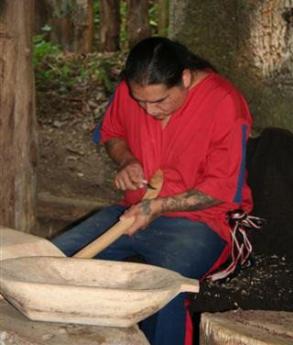



Wood carving is a vigorous Cherokee Indian craft.
Its styles have been shaped over time by White
mountain carvers, by woodwork taught at
boarding schools, and by the general art world.
But Cherokee Indian wood carving has keep its
original form. Early carving focused on household
utensils, such as ladles, spoons, and dough trays
which found an early outside market. A corn
beater called the “Ka-no-na,” was carved from
wood and used for the processing of corn into meal.
Pipe carving in stone and in rhododendron root was a major tradition in sculpture, and
provided cash income from outside markets throughout the eighteenth and nineteenth
centuries. Wood masks for ceremonial purposes would have a maket in the tourist trade.
Naturalistic and stylized life forms in full relief have been adapted from the animal and
human figurines on pipes and have carried over the strength and the grace of ancient
forms into modern wood sculpture. Cherokee Indian wood carving shows a history parallel to
that of basketry in its development.
Its styles have been shaped over time by White
mountain carvers, by woodwork taught at
boarding schools, and by the general art world.
But Cherokee Indian wood carving has keep its
original form. Early carving focused on household
utensils, such as ladles, spoons, and dough trays
which found an early outside market. A corn
beater called the “Ka-no-na,” was carved from
wood and used for the processing of corn into meal.
Pipe carving in stone and in rhododendron root was a major tradition in sculpture, and
provided cash income from outside markets throughout the eighteenth and nineteenth
centuries. Wood masks for ceremonial purposes would have a maket in the tourist trade.
Naturalistic and stylized life forms in full relief have been adapted from the animal and
human figurines on pipes and have carried over the strength and the grace of ancient
forms into modern wood sculpture. Cherokee Indian wood carving shows a history parallel to
that of basketry in its development.
Cherokee Indian Wood Carving



Cherokee Mask
Cherokee Corn Beater
